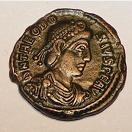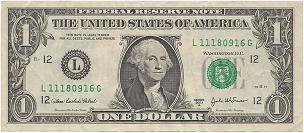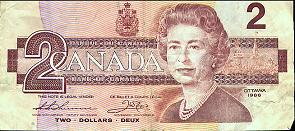Money
Pronunciation: /ˈmʌn.i/ ExplainMoney is something that represents value. One familiar form of money is the bills and coins used to pay for things such as food and clothing. Money can also be non-physical, like money in a bank account.
The need for money
When people want something, they have two options: make it or get it from someone else. Usually, if someone gives something to someone else, they want something in return. Herein lies a problem that money solves. Without money, if I want a sack of potatoes and I have a bushel of apples to trade for the sack of potatoes, I have to find someone that has a sack of potatoes they don't need and wants a bushel of apples. With money, I can trade the bushel of apples for money, then use the money to buy a sack of potatoes.
A brief history of money
People of the world have used many things to represent value. Some of the things they have used includes cowry shells, stone wheels, and pigs or cows. As people discovered mining and refining of precious metals, most cultures in the world settled on gold and silver coins as money. These coins had several advantages over other ways to represent value. They were relatively small and light. The metal in the coins had value all by itself. The precious metals were relatively soft and could be stamped into coins. Eventually, most cultures settled on metal coins for money and governments minted these coins.
Banks got their start with goldsmiths. Since goldsmiths usually had a secure environment to protect their precious metals, people began to leave their gold and silver with goldsmiths to keep it safe from robbers. Then some enterprising goldsmith got the idea that he could lend out the money he was keeping safe and charge interest. Soon many goldsmiths were receiving deposits and lending out money. Since the gold and silver on deposit was lent out, a deposit no longer mean actual physical money, but non-physical money.
Eventually, governments got the idea that they could store the gold and print bills that represented gold in government reserves. These bills were called gold certificates and silver certificates. If one presented such a certificate at the government bank, they could get the gold or silver it represented.
| Country | Image |
|---|---|
| Roman Empire |  |
| Table 1: Ancient coins | |
Later, governments printed bills that were not backed by actual silver and gold. Since people had become used to bills and coins representing value, they continued to use these bills and coins just as they had before.
Forms of money
In the modern world, the most important form of money is the non-physical form. This includes money deposited in checking and savings accounts. When a person uses their debit card to buy something no physical money is exchanged. A deposit is transferred from one bank account to another. Most money in the world today takes the form of deposit accounts.
Physical money takes the form of bills and coins. Each country or group of countries prints their own bills and mints their own coins. Some of the bills and coins from around the world are shown in table 1.
| Country | Base monetary unit | Bill | Coin | ||||||||||||
|---|---|---|---|---|---|---|---|---|---|---|---|---|---|---|---|
| United States | US Dollar ($) |  |
| ||||||||||||
| Canada | Canadian Dollar |  | |||||||||||||
| Table 1: Bills and coins from around the world | |||||||||||||||
Cite this article as:
McAdams, David E. Money. 12/21/2018. All Math Words Encyclopedia. Life is a Story Problem LLC. https://www.allmathwords.org/en/m/money.html.Image Credits
- All images and manipulatives are by David McAdams unless otherwise stated. All images by David McAdams are Copyright © Life is a Story Problem LLC and are licensed under a Creative Commons Attribution-ShareAlike 4.0 International License.
- Roman coin: Michail Benutzer, https://commons.wikimedia.org. This file is licensed under the Creative Commons Attribution-Share Alike 3.0 Unported license. https://commons.wikimedia.org/wiki/File:Theodosius_I._Roman_Coin.jpg.
- US $1 bill: Henrique, https://commons.wikimedia.org. Public domain. https://commons.wikimedia.org/wiki/File:United_States_one_dollar_bill,_obverse.jpg.
- Canadian $2 bill: JPDaigle. Public domain.
Revision History
12/21/2018: Reviewed and corrected IPA pronunication. (McAdams, David E.)9/4/2018: Initial version. (McAdams, David E.)
- Navigation
- Home
- Contents
-
# A B C D E F G H I J K L M N O P Q R S T U V W X Y Z - Teacher Aids
- Classroom Demos
- How To
- LIASP
- LIASP Home
- Conditions of Use
- Privacy Policy
- Donate to LIASP
- Help build this site
- About LIASP
- Contact LIASP
All Math Words Encyclopedia is a service of
Life is a Story Problem LLC.
Copyright © 2018 Life is a Story Problem LLC. All rights reserved.
This work is licensed under a Creative Commons Attribution-ShareAlike 4.0 International License